Introduction
Front
{{section_header}}{{section.name}}{{/section_header}}
Stainless steel. Blank. Small steam vent in upper left. Screw-on handle. The tasteful exterior belies the cheap, plastic interior.
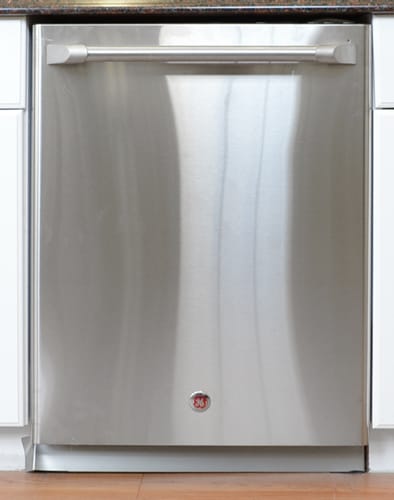
The front of the GE CDWT980VSS.
Finish
{{section_header}}{{section.name}}{{/section_header}}
The stainless finish is surprisingly resistant to fingerprints, although not entirely.

Controls
{{section_header}}{{section.name}}{{/section_header}}
The control panel is located on the top side of the door and is separated into “Cycles” and “Options.” The layout is intuitive and clearly labeled, with green lights to indicate selections.
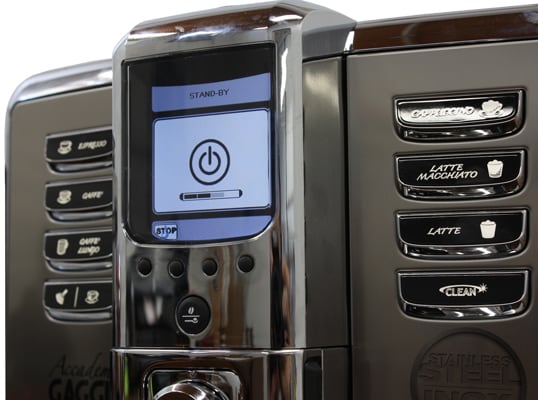
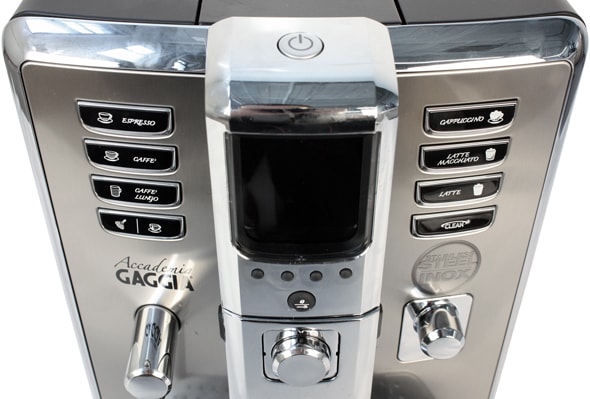
Interior
{{section_header}}{{section.name}}{{/section_header}}
The plastic interior is much less elegant than the exterior, but there was no indication that this affected the wash performance. The only downside here is that it makes for a pretty noisy wash.
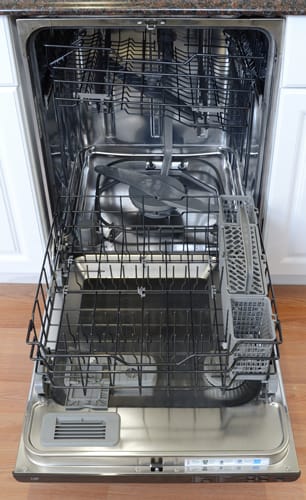
The CDWT980VSS with door open.
Top Rack
{{section_header}}{{section.name}}{{/section_header}}
Neither of the racks can be adjusted, but the layout of the tines on both allowed for considerable loading flexibility. A unique spiral-shaped wash arm is located beneath the top rack.
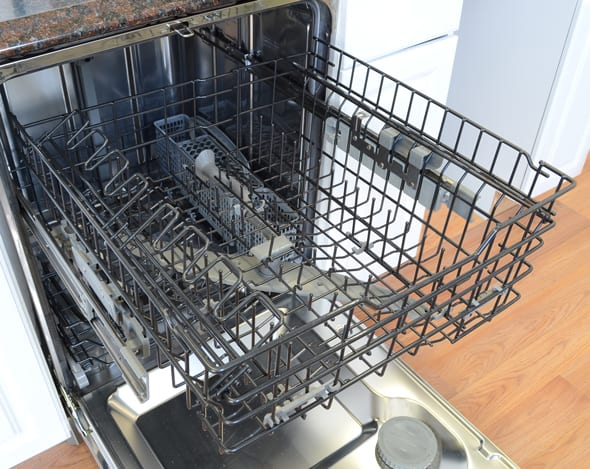
The top rack of the CDWT980VSS.
Bottom Rack
{{section_header}}{{section.name}}{{/section_header}}
The bottom rack also features a spiral-shaped wash arm beneath it. Like the top rack, the tines cannot be adjusted, but this wasn’t much of a problem when fitting dishware. In fact, we were able to position bulky pots, pans and ceramic bowls with ease.
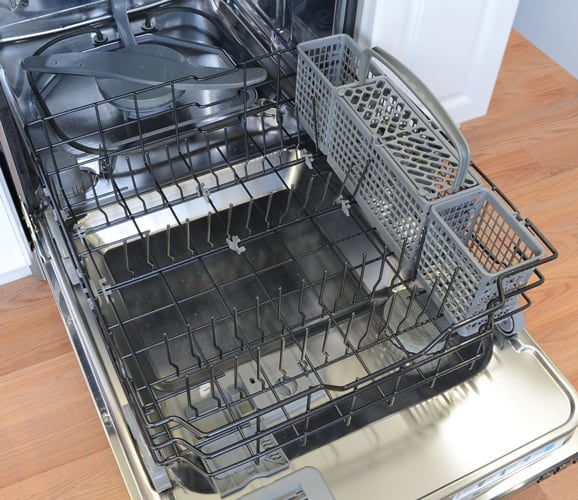
The bottom rack of the CDWT980VSS.
Cutlery Basket
{{section_header}}{{section.name}}{{/section_header}}
The cutlery basket is standard Whirlpool: two collapsible lids with cutlery holders, plus four interior bays. The whole contraption can only be fit on the right side of the bottom rack, but you shouldn’t have any trouble fitting even the largest of cutlery loads.
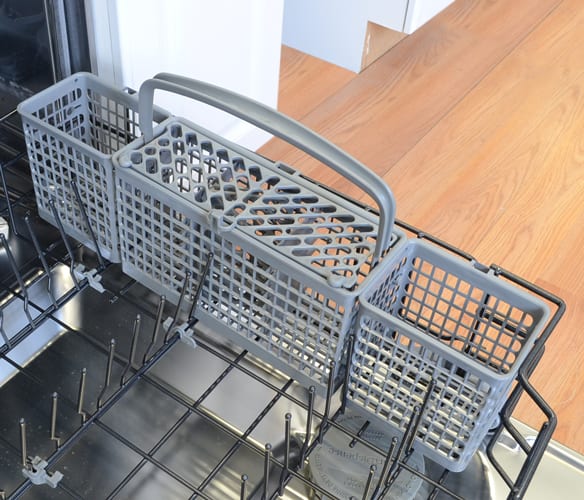
The CDWT980VSS cutlery basket.
Electricity Use
{{section_header}}{{section.name}}{{/section_header}}
None of the cycles exceeded 1 kWh in a single wash, even with the Sani Rinse option engaged. Specifically, we found the {{product.model}} consumed 0.35, 0.68, and 0.82 kWh between the 1 Hour Wash, Normal, and Pots & Pans cycles, respectively. This makes for an electricity cost of about 4 to 8 cents per wash.
Water Use
{{section_header}}{{section.name}}{{/section_header}}
Water consumption was a bit less efficient. The Normal and Pots & Pans cycles consumed 7.94 and 7.91 gallons of hot water, respectively. Even the 1 Hour Wash was pretty draining, taking in 5.23 gallons. In all, this makes for an average cost of 5 to 8 cents per cycle.
Yearly Running Cost
{{section_header}}{{section.name}}{{/section_header}}
The above efficiency data work out to an average cost per wash of 11, 18, or 20 cents per wash (1 Hour, Normal, and Pots & Pans, respectively). This means you can expect a yearly operating cost of about$34.64—not bad, but certainly not great.
{{comparison_bars title="Yearly Running Cost", attribute="Yearly Running Cost", xLabel="Cost to run over a typical year ($)"}}
Washing Speed
{{section_header}}{{section.name}}{{/section_header}}
The 1 Hour Wash lived up to its name, clocking in at 59 minutes, but the Normal and Pots & Pans cycle were significantly more time-consuming. The Pots & Pans wash took a whopping 179 minutes to complete, and the Normal wasn’t far below with 170 minutes. Most people are not overly concerned with speed, especially if said speed promises a thorough clean, but it’s certainly worth noting.
Washing Performance
{{section_header}}{{section.name}}{{/section_header}}
This is where the {{product.model}} was most impressive. Each of the cycles, including the 1 Hour Wash, scored impressively and attacked most stains with vigor. If you’re really only concerned with your dishwasher’s functionality, the {{product.model}} is certainly worth your consideration.
Quick Wash Cycle
{{section_header}}{{section.name}}{{/section_header}}
The 1 Hour Wash consumes more water and energy than your average quick cycle, but that’s because it’s using these resources to deliver as complete a clean as possible within a one-hour window. Given that, it’s performance is impressive, especially on difficult stains such as dried spinach and oatmeal. It also did well on protein-based stains, although our baked milk test proved a challenge.
Normal Wash Cycle
{{section_header}}{{section.name}}{{/section_header}}
In a scaled comparison, the {{product.model}}’s Normal cycle performed the best. Looking at the data you can see why: It was near perfect on several tests, and performed well above average on our lipstick stain, which is always the most difficult test. The thoroughness of the clean on the dried spinach stain was also impressive, as this test is also usually one of the more difficult ones. Excepting the egg, spinach, and lipstick tests, the {{product.model}} scored perfectly on each stain in at least one pass.
Normal Cycle
Heavy/Pots & Pans Wash Cycle
{{section_header}}{{section.name}}{{/section_header}}
The Pots & Pans cycle displayed average performance on our heavy-only stains (baked lasagna, burnt cheese, and burnt sugar), but it exceeded in the rest, especially in our dried spinach, burnt milk, and lipstick stains. Also, since this wash consumed a negligibly larger amount of water and energy, you don’t have to worry about using it more often than the Normal cycle.
Pots & Pans Cycle
Washing Cycles
{{section_header}}{{section.name}}{{/section_header}}
The {{product.model}} includes four cycles: 1 Hour Wash, Normal, Pots & Pans, and “SmartWash,” which senses soil amount and intensity to determine the appropriate heat and water demands.
Customization
{{section_header}}{{section.name}}{{/section_header}}
There are a few customization options, all of which can be added manually to a given cycle. They include: High Temperature rinse, Sanitize Rinse, and Heated Dry.

Additional Wash Options
{{section_header}}{{section.name}}{{/section_header}}
Aside from the above customization options, there is a four-hour delay feature that can be added to any cycle. There’s also a control lock, which is helpful for households with rambunctious children.

Capacity
{{section_header}}{{section.name}}{{/section_header}}
We were able to fit 10 place settings, including a serving setting, which is by all means an average score.
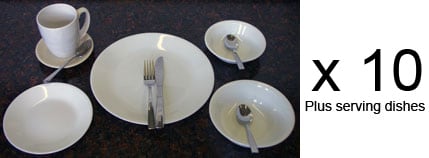
Top Rack
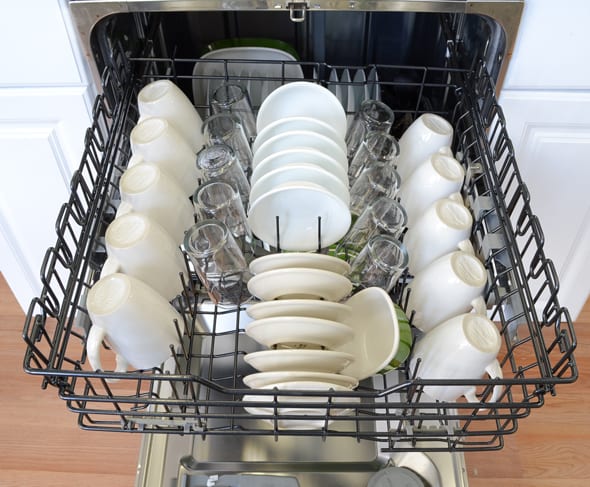
Bottom Rack
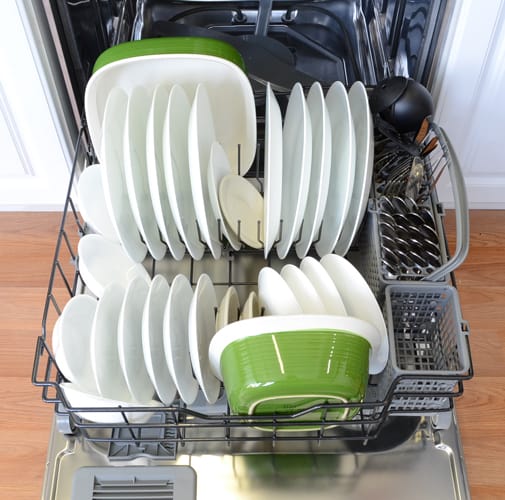
Wash Arms & Filters
{{section_header}}{{section.name}}{{/section_header}}
It’s hard to put a finger on why this machine performed so well, but the only unique feature we can imagine is the odd shape of the wash arms. They’re spiraled in a way that, we imagine, helps water reach even the most hard-to-get spots.
The filter is also standard. It includes two removable parts that are very easy to clean.
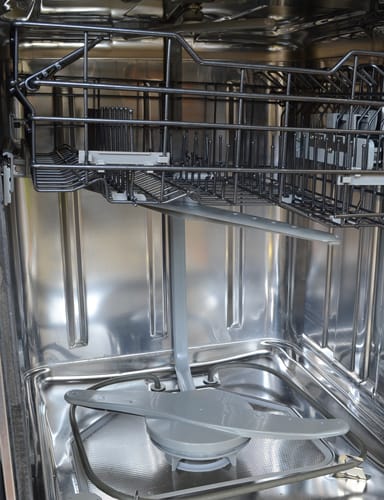
The CDWT980VSS wash arms.
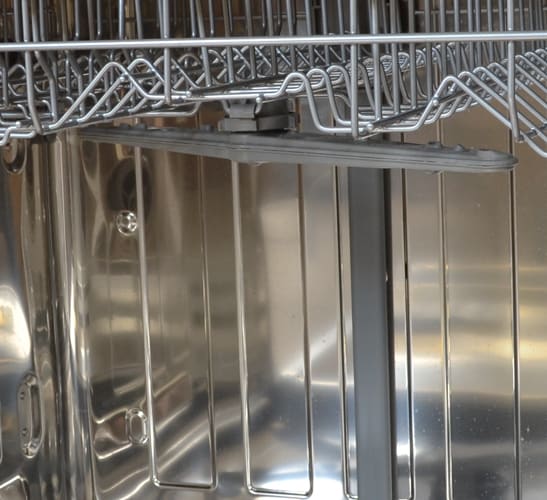
The DW 14140 upper wash arm
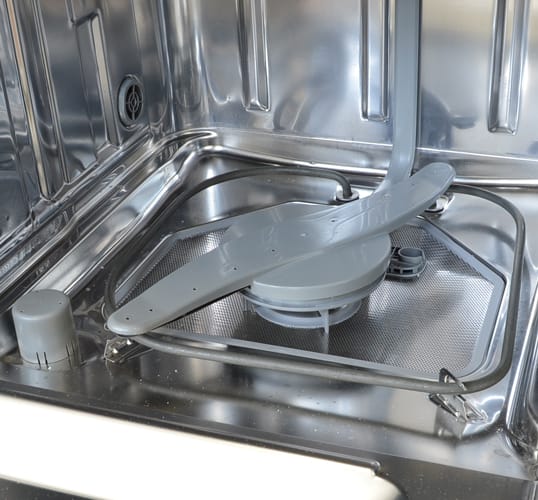
The CDWT980VSS filter.
Lower Dish Rack
{{section_header}}{{section.name}}{{/section_header}}
The lower rack slides a bit too easily in and out of the tub. We even had to catch it from falling out a few times. With a full load this isn’t much of a concern, but it’s still worth it to be careful.

The bottom rack of the CDWT980VSS.
Upper Dish Rack
{{section_header}}{{section.name}}{{/section_header}}
Like the bottom rack, the top felt a bit flimsy and cheaply constructed. We were also annoyed by the lack of adjustability, but the tines were placed in such a way that we had no trouble fitting dishes, even bulky or oddly shaped materials.

The top rack of the CDWT980VSS.
Cutlery Holder
{{section_header}}{{section.name}}{{/section_header}}
The cutlery basket also feels a little cheap, but it’s spacious and includes two foldable lids with utensil holders.

The CDWT980VSS cutlery basket.
Detergent Dispenser
{{section_header}}{{section.name}}{{/section_header}}
Like most of the {{product.model}}’s interior, the detergent dispenser is ugly. The text is colored in an obnoxious red that makes the whole thing look like a warning. Other than this cosmetic triviality, it’s a standard dispenser with one measuring line and a removable rinse aid lid.
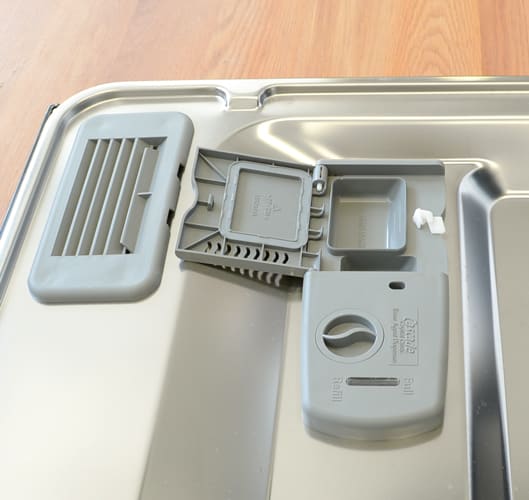
The CDWT980VSS detergent dispenser.
Ease of Use
{{section_header}}{{section.name}}{{/section_header}}
Like most other Whirlpool-made dishwashers, the {{product.name}} is simple to use, with the same rack layout and cutlery design as countless other Maytags, Whirlpools, and KitchenAids.
Noise
{{section_header}}{{section.name}}{{/section_header}}
The sloshing of water in the plastic tub makes for a loud wash cycle. You may want to take note of this before buying. Most folks don’t care about how loud their dishwasher is—assuming it’s not, like, supersonic-jet-loud—but if you’re in a loft or some sort of home with a bed near the kitchen, it may bother you.
Controls
{{section_header}}{{section.name}}{{/section_header}}
The control panel is operated via push buttons, each of which includes a small green light to indicate selections. Each button is clearly labeled to ensure proper use.


Efficiency
{{section_header}}{{section.name}}{{/section_header}}
With a yearly operating cost of $34.64, it’s not very efficient. This isn’t a bad figure—it’s just okay. The upside is that there isn’t much of an efficiency difference between the Normal and Pots & Pans cycles, which means you don’t have to worry about racking up your bills by using the heavy cycle more often.
Washing Performance
{{section_header}}{{section.name}}{{/section_header}}
All three of the main cycles—1 Hour Wash, Normal, and Pots & Pans—scored very well for their respective category. The Normal was the best, as it did well on both our dried spinach and lipstick tests, which are usually two of the most difficult stains to clean. Even the quick cycle—the 1 Hour Wash—did well, having scored higher than 90% clean on all but the lipstick stain (which rarely ever exceeds 25%).
Features
{{section_header}}{{section.name}}{{/section_header}}
There aren’t many extra features or wash options, but that’s not what makes this dishwasher so great. There’s a Sanitize Rinse (which reached the sufficiently high temperature of 157.6 degrees, enough to kill bacteria), a delay, a heated dry and a high-temperature rinse (which is basically the same as a Sani Rinse), and a “SmartWash” sensor cycle. This isn’t a whole lot, but you really won’t need anything else, and you’d be hard-pressed to find better wash performance for $500. Go ahead, try.
Meet the tester
Tyler Wells Lynch is a freelance writer and journalist whose work has appeared in Vice, Wirecutter, Gizmodo, The Rumpus, Yes!, and the Huffington Post, among others. He lives in Maine.
Checking our work.
Our team is here to help you buy the best stuff and love what you own. Our writers, editors, and experts obsess over the products we cover to make sure you're confident and satisfied. Have a different opinion about something we recommend? Email us and we'll compare notes.
Shoot us an email